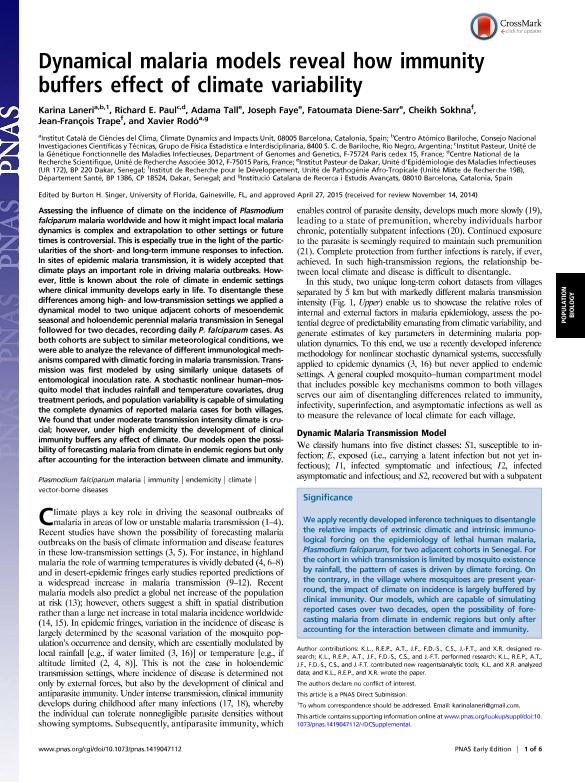Artículo
Dynamical malaria models reveal how immunity buffers effect of climate variability
Laneri, Karina Fabiana ; Paul, Richard E.; Tall, Adama; Faye, Joseph; Diene Sarr, Fatoumata; Sokhna, Cheikh; Trape, Jean François; Rodó, Xavier
; Paul, Richard E.; Tall, Adama; Faye, Joseph; Diene Sarr, Fatoumata; Sokhna, Cheikh; Trape, Jean François; Rodó, Xavier
 ; Paul, Richard E.; Tall, Adama; Faye, Joseph; Diene Sarr, Fatoumata; Sokhna, Cheikh; Trape, Jean François; Rodó, Xavier
; Paul, Richard E.; Tall, Adama; Faye, Joseph; Diene Sarr, Fatoumata; Sokhna, Cheikh; Trape, Jean François; Rodó, Xavier
Fecha de publicación:
06/2015
Editorial:
National Academy of Sciences
Revista:
Proceedings of the National Academy of Sciences of The United States of America
ISSN:
0027-8424
Idioma:
Inglés
Tipo de recurso:
Artículo publicado
Clasificación temática:
Resumen
Assessing the influence of climate on the incidence of Plasmodium falciparum malaria worldwide and how it might impact local malaria dynamics is complex and extrapolation to other settings or future times is controversial. This is especially true in the light of the particularities of the short- and long-term immune responses to infection. In sites of epidemic malaria transmission, it is widely accepted that climate plays an important role in driving malaria outbreaks. However, little is known about the role of climate in endemic settings where clinical immunity develops early in life. To disentangle these differences among high- and low-transmission settings we applied a dynamical model to two unique adjacent cohorts of mesoendemic seasonal and holoendemic perennial malaria transmission in Senegal followed for two decades, recording daily P. falciparum cases. As both cohorts are subject to similar meteorological conditions, we were able to analyze the relevance of different immunological mechanisms compared with climatic forcing in malaria transmission. Transmission was first modeled by using similarly unique datasets of entomological inoculation rate. A stochastic nonlinear human-mosquito model that includes rainfall and temperature covariates, drug treatment periods, and population variability is capable of simulating the complete dynamics of reported malaria cases for both villages. We found that under moderate transmission intensity climate is crucial; however, under high endemicity the development of clinical immunity buffers any effect of climate. Our models open the possibility of forecasting malaria from climate in endemic regions but only after accounting for the interaction between climate and immunity.
Archivos asociados
Licencia
Identificadores
Colecciones
Articulos(CCT - PATAGONIA NORTE)
Articulos de CTRO.CIENTIFICO TECNOL.CONICET - PATAGONIA NORTE
Articulos de CTRO.CIENTIFICO TECNOL.CONICET - PATAGONIA NORTE
Citación
Laneri, Karina Fabiana; Paul, Richard E.; Tall, Adama; Faye, Joseph; Diene Sarr, Fatoumata; et al.; Dynamical malaria models reveal how immunity buffers effect of climate variability; National Academy of Sciences; Proceedings of the National Academy of Sciences of The United States of America; 112; 28; 6-2015; 8786-8791
Compartir
Altmétricas



